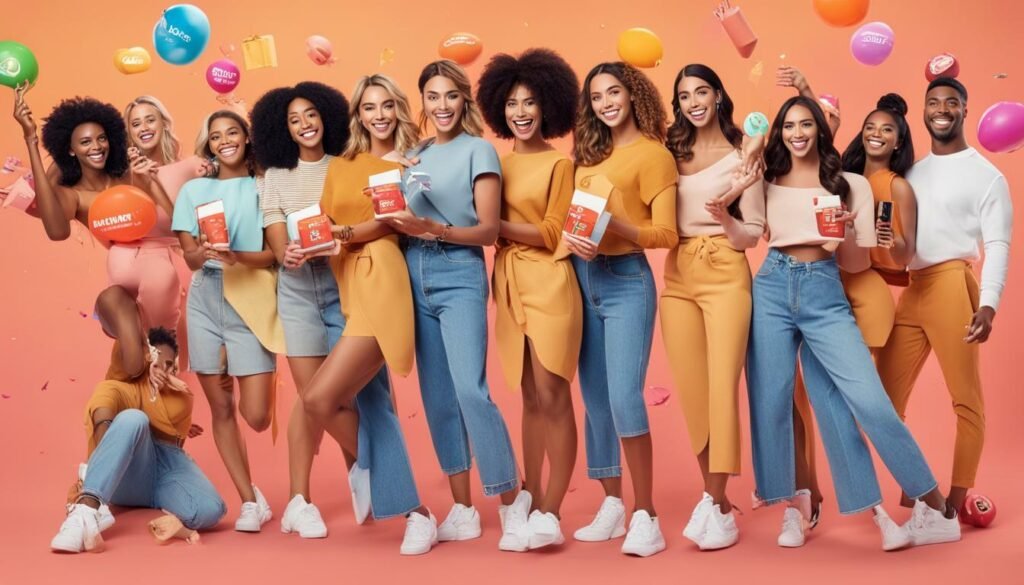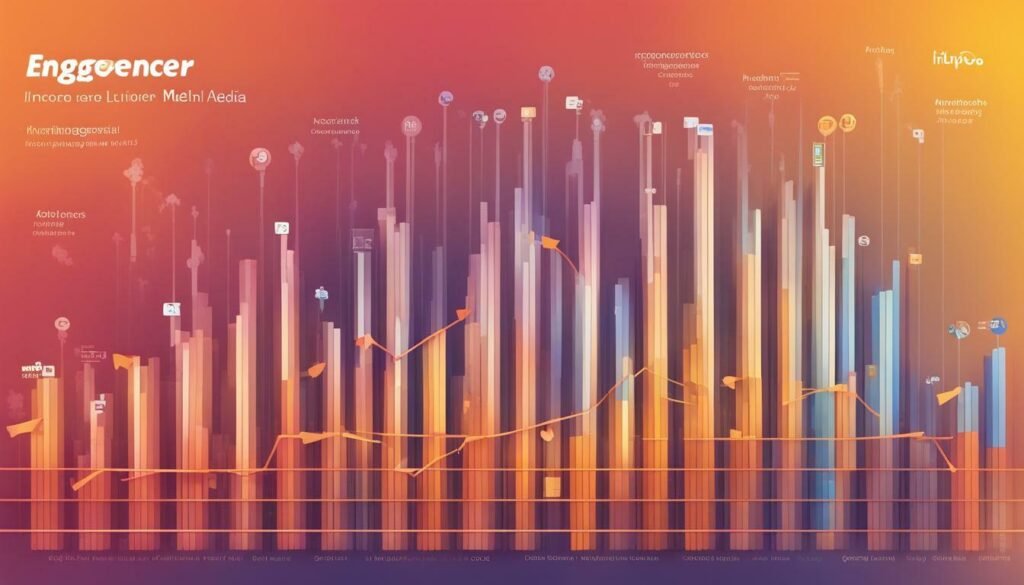Welcome to our in-depth article on influencer marketing in the years 2023-2024. As the industry continues to evolve, businesses are facing new challenges and opportunities in their influencer marketing strategies. In this article, we will explore the current landscape of influencer marketing, discuss the trends and predictions for the future, and provide strategies for businesses to succeed in this dynamic field.
Key Takeaways:
- Influencer marketing is an ever-evolving industry that presents both challenges and opportunities for businesses.
- Effective strategies for influencer partnerships and campaigns are essential for success.
- Measuring the success of influencer marketing campaigns and maintaining compliance and ethical standards are crucial for credibility and trust.
- Staying abreast of the changing influencer marketing landscape and consumer behavior is key to future success.
The Evolution of Influencer Marketing
Influencer marketing has come a long way since its inception. It has evolved from a novelty to a full-fledged industry that generates billions of dollars in revenue each year. As businesses continue to recognize the importance of this marketing strategy, new trends and changes are constantly emerging.
One of the biggest trends in influencer marketing is the shift towards micro-influencers. These are influencers with smaller followings, typically between 10,000 and 100,000 followers. Micro-influencers are known for their highly engaged audiences and are often more affordable for brands to partner with. This trend has also led to an increased focus on niche influencers, who have a highly targeted and loyal following in specific areas.
Another trend that has emerged in recent years is the use of long-term influencer partnerships. Rather than working with multiple influencers for one-off campaigns, brands are now forging longer-term partnerships with select influencers. This allows for a deeper connection between the brand and influencer, resulting in more authentic content and increased trust with the audience.
Furthermore, the rise of social media platforms such as Instagram and TikTok has had a significant impact on influencer marketing. Instagram is still the most popular platform for influencer collaborations, but TikTok is quickly gaining ground, particularly with younger audiences. This has led to the emergence of new types of influencers, such as TikTok stars, who have built massive followings on the platform.
As influencer marketing continues to evolve, it’s important for businesses to stay up-to-date with the latest trends and changes. By doing so, they can ensure that their influencer marketing strategies remain effective and relevant in the years to come.

Establishing Effective Influencer Partnerships
Successful influencer marketing campaigns are built upon strong collaborations between brands and influencers. To establish effective partnerships, it is crucial to identify the right influencers for your brand and maintain clear communication throughout the process.
When identifying potential influencers, it is important to consider factors such as audience demographics, content quality and authenticity. The right influencer should align with your brand’s values and target audience. Tools such as influencer marketing platforms and social listening software can help identify suitable candidates based on metrics such as engagement rates and follower demographics.
Once suitable influencers have been identified, the next step is to initiate outreach and establish a rapport. Personalized messages that demonstrate an understanding of the influencer’s content and audience can go a long way in establishing a meaningful partnership. Be transparent about your expectations and goals for the collaboration, and be open to the influencer’s creative input.
Clear communication throughout the collaboration is essential. Establish a timeline and deliverables, and make sure to provide the influencer with the necessary resources and information they need to create content that aligns with your brand’s message. Providing guidelines and examples of successful collaborations can also set clear expectations and ensure both parties are on the same page.
Finally, maintaining a positive relationship with your influencer partners is crucial for long-term success. Show appreciation for their work and provide opportunities for ongoing collaborations. Building a strong network of trusted influencer partners can lead to greater success in future campaigns.

Crafting Compelling Influencer Marketing Campaigns
Creating impactful influencer marketing campaigns requires a thorough planning and execution process, one that resonates with your target audience and delivers measurable results.
First, identify your campaign goals and objectives. Determine what you want to achieve, whether it’s increasing brand awareness, driving sales, or fostering engagement. Next, identify the right influencers for your campaign, those whose interests, content, and audience align with your brand and campaign objectives. Consider factors such as engagement rates, audience demographics, and content relevancy.
Once you have identified your influencers, establish clear campaign guidelines and expectations. Communicate your campaign goals, timelines, and messaging requirements, and provide the necessary tools and resources to help influencers create compelling content.

To achieve authenticity and ensure that the campaign messaging aligns with your brand, consider collaborating with influencers on the content creation process, this allows them to showcase their creativity while staying on message.
Finally, measure the success of your campaign. Track key performance indicators such as engagement rates, traffic, and conversions, compare them to your campaign goals, and optimize your strategy accordingly.
The Power of Co-Creation
Collaborating with influencers on campaign creation can be a highly effective strategy. Co-creation has been used by brands such as Adidas, Fenty Beauty, and Airbnb to create campaigns that authentically reflect their values and ethos while still resonating with their audience.
The key to successful co-creation is to give influencers creative freedom while aligning the campaign messaging with your brand values and objectives. – Adidas
Co-creation fosters a sense of ownership and investment in the campaign, which in turn motivates influencers to actively promote it, resulting in higher engagement and conversions. Incorporating influencer feedback into the campaign can also help to refine its messaging and ensure it resonates with your target audience.
Overcoming Challenges in Influencer Marketing
While influencer marketing has become an essential part of many brands’ marketing strategies and has proven to be effective, there are still challenges that businesses may encounter in their influencer collaborations and campaigns.
One of the biggest challenges in influencer marketing is the prevalence of fake followers and influencer fraud. Many influencers may boost their follower count artificially to appear more influential, but this can lead to ineffective campaigns and a lack of authenticity in partnerships.
To overcome this challenge, it’s important to thoroughly research potential influencers and analyze their engagement and metrics. In addition, brands can work with influencer marketing platforms and agencies that provide verified influencers with authentic followings.
Another challenge in influencer marketing is maintaining authenticity and transparency in partnerships. Brands and influencers must adhere to FTC guidelines and disclose sponsored content to their followers to build trust and credibility with their audience.
Additionally, influencer collaborations require effective communication and alignment between brands and influencers. Misaligned goals and expectations can result in unsuccessful campaigns and strain the partnership.
By addressing these challenges and implementing strategies for success, businesses can navigate the influencer marketing landscape and achieve their marketing goals.

The Future of Influencer Marketing: Trends and Predictions
As we look ahead to the years 2023-2024, it’s clear that influencer marketing will continue to play a significant role in the marketing landscape. The industry has been evolving rapidly, and we expect to see several new trends and shifts in the coming years.
1. The Rise of Micro-Influencers
While mega-influencers have been the stars of influencer marketing for years, we predict a shift towards micro-influencers in the future. These influencers typically have smaller but more niche audiences, which can be highly engaged and loyal. Brands will increasingly seek out micro-influencers to reach specific target markets.
2. Increased Emphasis on Authenticity
Consumers are becoming increasingly savvy about influencer marketing, and they can spot inauthentic partnerships from a mile away. As a result, we predict that brands will place greater emphasis on authenticity and transparency in their influencer partnerships, prioritizing long-term collaborations with authentic influencers over one-off sponsored posts.
3. The Emergence of New Platforms
Influencer marketing has traditionally been focused on Instagram, but we predict that new platforms will emerge in the coming years. Platforms like TikTok and Twitch are already gaining traction with younger audiences, and we expect to see brands experimenting with these platforms in the future.
| Influencer Marketing Trends for the Years 2023-2024 |
|---|
| The rise of micro-influencers |
| Increased emphasis on authenticity and transparency |
| The emergence of new platforms |
4. Integration with E-commerce
We predict that influencer marketing will become increasingly integrated with e-commerce in the future. Many brands are already experimenting with in-app purchasing and other e-commerce features on influencer posts, and we expect this trend to continue as platforms like Instagram and TikTok seek to monetize their content.
5. Growing Importance of Diversity and Inclusion
Influencer marketing has historically been criticized for a lack of diversity and inclusion. However, we predict that brands will place greater emphasis on partnering with influencers from diverse backgrounds in the years ahead. This will not only help to create a more inclusive marketing landscape but also provide an opportunity for brands to reach new audiences.
Overall, the future of influencer marketing looks bright, with new trends and opportunities on the horizon. Brands that stay ahead of these trends and embrace the evolving influencer marketing landscape will be well-positioned for success in the years 2023-2024.
The Importance of Measuring the Success of Influencer Collaborations
Measuring the success of influencer marketing campaigns is crucial in determining whether your collaborations have achieved your business goals. Without analyzing performance metrics, it is difficult to assess how effective your collaborations have been or to optimize future campaigns.
Key performance indicators (KPIs) should be established prior to launching your campaign. These may include metrics such as engagement rate, reach, click-through rates, conversions or sales. By setting these KPIs, you will have a better understanding of the goals you want to achieve and what metrics to measure.
It’s important to note that measuring the success of influencer collaborations is not solely based on quantitative data. Qualitative data, such as brand mentions, sentiment analysis, and user-generated content can also provide valuable insights into how the campaign has been received by the audience. By analyzing both quantitative and qualitative metrics, you can gain a comprehensive understanding of the success of your influencer collaborations.
One tool that can assist in tracking and analyzing influencer campaign performance is Google Analytics. By implementing UTM tracking codes on links shared by influencers, you can track their traffic and monitor the success of your campaign.

In conclusion, measuring the success of influencer collaborations is essential in ensuring that your campaigns have achieved the desired results. By establishing KPIs, tracking metrics, and analyzing both quantitative and qualitative data, you can optimize future campaigns and build successful collaborations with influencers.
The Importance of Compliance and Ethical Standards
As we continue to see the growth of influencer marketing, it’s important for businesses to maintain ethical and compliant practices in their partnerships. By adhering to guidelines and regulations, brands can ensure credibility and build trust with their audience.
| Transparency and Disclosure | Adherence to Guidelines |
|---|---|
|
Transparency is key when it comes to influencer marketing. Brands must disclose the nature of their partnerships with influencers, including any compensation or free products provided. This information should be clearly stated in posts and captions, and not buried in a sea of hashtags. |
Guidelines for influencer marketing vary by platform and region, so it’s important to stay up-to-date on the latest rules and regulations. In the United States, for example, the Federal Trade Commission (FTC) requires influencers to disclose sponsored content or risk facing fines. Brands should ensure that their influencers are aware of these guidelines and follow them accordingly. |
By prioritizing compliance and ethical standards, businesses can cultivate genuine relationships with their audience and partners, ultimately leading to long-term success in the influencer marketing landscape.

Conclusion
As we conclude, it is evident that influencer marketing is here to stay and will continue to evolve in the years 2023-2024. To succeed in this dynamic landscape, businesses must develop effective strategies that align with their brand values and resonate with their target audience.
Collaborating with the right influencers and creating compelling campaigns that deliver measurable results will be crucial for businesses to stand out from the competition. However, it is equally important to address the challenges that come with influencer marketing, such as fake followers and maintaining authenticity.
The Future of Influencer Marketing
In the years 2023-2024, we can expect to see new platforms and technologies emerging, such as virtual reality and artificial intelligence, which will provide exciting opportunities for influencer marketing campaigns. The role of influencers is also expected to evolve, with nano and micro-influencers potentially having more significant impact on niche audiences.
Ultimately, measuring the success of influencer marketing campaigns and maintaining compliance with ethical standards will be critical for building credibility and trust with consumers.
In summary, influencer marketing is an ever-changing landscape that requires businesses to be adaptable and strategic in their approach. By staying up to date with the latest trends, developing effective partnerships, and measuring success, businesses can thrive in the years 2023-2024 and beyond.
FAQ
Q: What is influencer marketing?
A: Influencer marketing is a form of marketing that involves partnering with influential individuals, known as influencers, to promote a brand or product to their audience. Influencers typically have a large following on social media platforms and can help businesses reach and engage with their target market.
Q: Why is influencer marketing important?
A: Influencer marketing is important because it allows businesses to tap into the trust and credibility that influencers have built with their audience. By partnering with influencers, businesses can leverage their influence to promote their brand, increase brand awareness, and drive sales.
Q: How do I find the right influencers for my brand?
A: Finding the right influencers for your brand involves conducting thorough research and analysis. Look for influencers who align with your brand values, have a relevant audience, and engage with their followers. Tools such as influencer marketing platforms and social media listening tools can help you identify potential influencers.
Q: How do I collaborate with influencers?
A: Collaborating with influencers involves establishing a mutually beneficial relationship. Clearly communicate your goals and expectations, and work together to create content that resonates with their audience. Provide influencers with the necessary resources and support to promote your brand effectively.
Q: How do I measure the success of influencer marketing campaigns?
A: The success of influencer marketing campaigns can be measured using key performance indicators (KPIs) such as reach, engagement, conversion rates, and sales. Track these metrics using analytics tools and compare them to your campaign goals to assess the effectiveness of your influencer collaborations.
Q: What are the common challenges in influencer marketing?
A: Common challenges in influencer marketing include fake followers, influencer fraud, maintaining authenticity, and ensuring compliance with regulations and ethical standards. Businesses need to be aware of these challenges and implement strategies to overcome them.
Q: What are the future trends in influencer marketing?
A: The future of influencer marketing is expected to see the emergence of new platforms and technologies, the evolving role of influencers, and the impact of changing consumer behavior. Businesses should stay up to date with these trends to remain competitive in the influencer marketing landscape.
Q: How can I ensure compliance and ethical standards in influencer marketing?
A: To ensure compliance and ethical standards in influencer marketing, businesses should focus on transparency, disclosure of partnerships, and adherence to guidelines set by regulatory bodies. It is essential to maintain credibility and trust in influencer partnerships.

